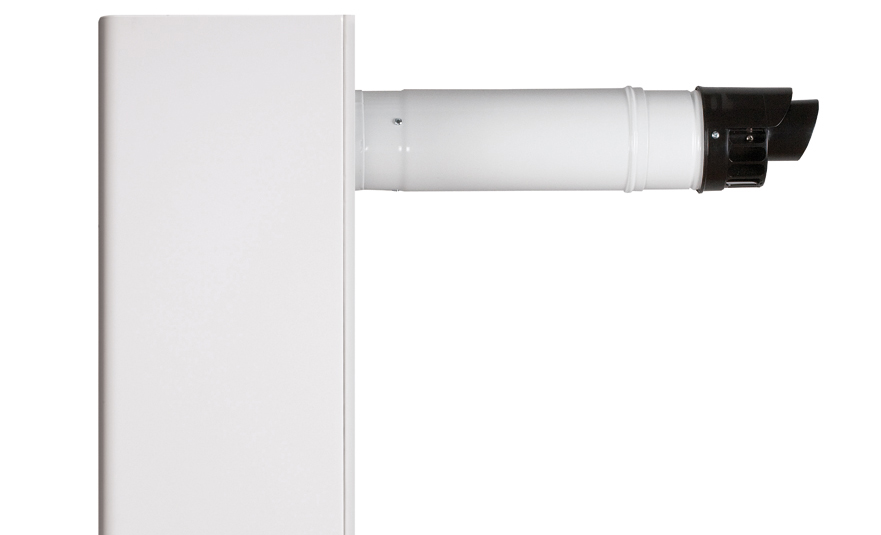
Although the majority of flueing systems for modern domestic condensing boilers can be relatively straightforward, there will always be installations that require flexibility in siting and sizing. Eric Brawley, Technical Co-Ordinator at Vokèra by Riello, tackles the topic of non-standard flueing.
A correctly specified and fitted flue is an essential element of a safe and efficient condensing boiler installation. The planning and positioning of the flue is key to keeping people safe from potentially harmful gases and Boiler Flue Regulations are in place to ensure installations meet strict health and safety standards.
While most of the flueing requirements that installers encounter on a day-to-day basis will be pretty standard, we believe it is important to be ready and able to deal with more unusual situations should they arise. It is for this reason that we run comprehensive courses covering all aspects of Vokèra boiler installation and commissioning, including flueing, and offer an extensive range of flue variants for all our domestic boilers. Indeed, some of the longest runs possible in the industry are permissible with our flue accessories in both horizontal and vertical options.
Key considerations
There are, of course, some key considerations when siting any flue for a condensing boiler. Mitigating the possible nuisance of pluming is just one of these considerations. BS5440-1, which covers the flueing and ventilation of gas appliances, specifies the minimum clearances for flue terminal locations to prevent a plume of condensate causing an issue for neighbouring properties or public spaces.
As well as the nuisance factor, plumes of water vapour may also cause damp patches on surfaces near the flue terminal. In addition to compliant siting of the flue, installers could also consider using a plume diversion kit, or designing a longer flue to help manage pluming.
Length matters
A non-standard flue will often relate to the length. For example, a longer run may be required when relocating an existing boiler, or where a standard flue isn’t practical for the preferred siting of a new boiler. Installers should always check the maximum overall length against the boiler model they are planning to use as they do vary. For most domestic condensing boilers a standard flue is a 100/60mm concentric. Flue extension lengths are generally available for this type of flue but usually up to a maximum of around two metres. Larger concentric flue systems of 125/80mm are also offered by most manufacturers and some may be extended but, again, only up to a maximum of about two metres.
For installations that require greater lengths a twin parallel flue system may be available. On some Vokèra models this type of flue can be up to 50 metres on each of the air duct and flue duct, which should cover most requirements. When using our twin pipe systems installers are advised to terminate them with a collector box and a single horizontal or vertical 125mm OD terminal or a two port terminal gate.
Adequate support
Whatever type of flue system is selected it must be adequately supported throughout its length. For flues concealed within a void access must be provided (300 by 300mm) within 700mm of every joint (although this is not necessary with a flexible flue in a constructional chimney).
Details of requirements relating to flues in voids were published in a 2019 Gas Safe Register Technical Bulletin and refer to properties, most likely flats or apartments, which have a room sealed, fan assisted boiler with a flue which is concealed behind a ceiling or wall. As the flue removes potentially harmful fumes from the boiler, it needs to be accessible for inspection by an engineer, either as part of the annual safety check or in the event of a problem with the heating system.
Rear flueing
For some situations, a rear flue option can offer a versatile alternative to a standard top flue. Where space is at a premium, for example, running the flue directly from the rear of the boiler will keep the overall installation footprint to a minimum. This type of flue can also increase siting flexibility for practical and aesthetic purposes. The direct rear flue option for Vokèra boilers is telescopic and can be cut to 320mm minimum and is adjustable between 600 and 825mm maximum for optimum versatility.
Verification requests
Following the 2019 Gas Safe Register Bulletin regarding verification that an unusual flue installation complies with the manufacturer’s instructions, Vokèra’s Technical Team has been receiving regular confirmation requests on installations. In order to provide verification we simply ask the attending engineer to supply some photographs of the installation, together with the project address and dimensions. If it has been installed correctly, we will keep a record of the communication from the engineer so no one is in doubt that it is compliant.
Be safe, not sorry
Correct flueing is a critical aspect of a condensing boiler installation with health and safety implications that shouldn’t be underestimated. As such, flueing should be given careful consideration on every installation, regardless of whether it’s a standard system or a more complex design. At Vokèra we advise installers to always check the boiler manufacturer’s instructions and to seek expert advice if they are in any doubt, because it is better to be safe than sorry.












